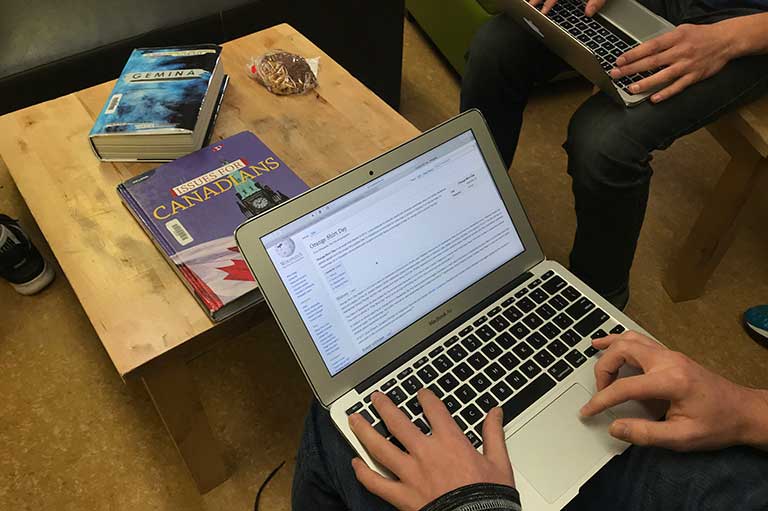A Missed Opportunity: Teaching the Canadian Rebellion (1837-38)
In November 1837, following a political impasse that had paralyzed Lower Canada for decades, members of the Parti patriote — a local revolutionary political party comprised of mostly (but not exclusively) French Canadians — revolted against British rule.
Craving reform and the creation of an American-style republic, they no longer believed that such important transformations could be achieved through peaceful means — the British government had, until then, rejected their demands and even ordered the arrest of several patriote leaders. Rebellion was their only option.
Though the insurrection began with a patriotes victory at Saint-Denis, the outnumbered and out armed revolutionaries were subsequently defeated at Saint-Charles and Saint-Eustache. In the meantime, Upper Canadians that also sought the creation of an American-style republic revolted.
However, in early December 1837, they were defeated near Brantford and at Montgomery’s Tavern. Following these defeats, Lower and Upper Canadian revolutionaries sought refuge in the United States. Throughout 1838, with the support of American sympathizers, they participated in numerous raids against British and loyalists forces in the Canadas, culminating in major defeats in November and December 1838, effectively ending the Canadian Rebellion.
Today, the Rebellion — in Québec, at least — is one of the most studied historical events, as each year new books, articles, encyclopedia entries, and graduate theses are produced.2 Moreover, the past two decades have seen our knowledge of this event expand significantly.
For example, several historians, such as Andrew Bonthius, Michel Ducharme, Louis-Georges Harvey, and Albert Schrauwers, have moved beyond conventional national narratives and have placed the Rebellion in a wider transnational context, analysing it in the context of the Age of Revolutions, Jacksonian America, the Atlantic World, and international diplomacy. Others have also challenged several accepted narratives, such as our focus on the conflict between French and English-speakers.3
For example, my good friend, Julien Mauduit, and I recently published a book — Revolutions across Borders: Jacksonian America and the Canadian Rebellion — that placed the Rebellion in the context of Jacksonian Democracy and demonstrated that the root of the conflict was not ethnocultural, but political, pitting supporters of republicanism (which included French Canadian, American, Scottish, English, Irish, Polish, and Jewish people) against Tories.4
The historiography of the Rebellion has thus undergone some tremendous changes in the past few decades. However, have these changes had an impact beyond academia? In a 2015 graduate memoir, Jonathan Larocque analysed the representation of the Rebellion in Québec’s high school history textbooks from 1982 and 2006 and discovered that they mostly tell an outdated story.5
Much has changed, however, since Larocque’s analysis, including the publication of new textbooks and a reform of the province’s high school Canadian history course in 2017. In this short text, I will examine how the Rebellion is portrayed in the most recent textbooks, many of which resulted from this latest reform.
However, I will go further and analyse, in comparison, the most recent government-approved textbooks in Ontario and Alberta. First, I will show that although textbooks in Québec tell a more updated story, they all suffer from the same problems.
Second, I will demonstrate that the place the Rebellion occupies in our textbooks is representative of the place it has in our conflicting collective identities. And finally, I will conclude by offering a few remarks explaining why I believe we must rethink the way that we teach the Canadian Rebellion in middle and high schools across Canada.
Collective Identities and the Canadian Rebellion
In Québec, the Rebellion has become an important part of our history and our collective identity. It is everywhere: it is in numerous songs, plays, and poems, and it is even celebrated with a beer, Unibroue’s 1837, brewed in honour of the memory of those that sacrificed their lives in the name of liberty at Saint-Eustache. And while the rest of Canada celebrates Victoria Day, in Québec, each year, we instead celebrate, La Journée nationale des patriotes.
Our bookstores and libraries are also full of books on the Rebellion. These books, however, focus almost entirely on Quebec and have presented the Rebellion as a battle between French Canadians and the British. For example, the last book on the topic that was aimed at a general readership, Gilles Laporte’s Brève Histoire des Patriotes, is a perfect example of this.
To Laporte, who’s books have become the dominant narrative amongst non-academics in Quebec, the Rebellion in Quebec was much more than a push for reform and responsible government, it was a movement by a French-Canadian population trying to rid itself of the shackles of British domination.
“En se portant à la défense d’une majorité historique de langue et de culture française,” Laporte explains, “les patriotes sont amenés à réclamer des droits que nous jugeons aujourd’hui fondamentaux.”6 This perspective fits perfectly within Québecois nationalism, which is firmly anchored on the importance of Québécois values, culture, and the French language.
Outside of Québec, it is the complete opposite: the Rebellion has not become a major part of English-speaking settler identity. There is no holiday celebrating the Rebellion in Upper Canada. It is not equally celebrated in plays, books, and poems. Moreover, it has all but disappeared from the historiography.
Limited to a few articles and non-academic manuscripts, here and there, it has been thirty years since Colin Read’s The Rising in Western Upper Canada, 1837-1838. This book is not only one of the last academic manuscript on the topic, but for those of you that read it, you will recall that it does not provide a very positive image of the event.
Similar to Laporte in Québec, Read’s arguments have become a dominant narrative. Mackenzie, Duncombe, and their supporters are portrayed as marginalized, disorganized, radicals, and lacking any real support. The Rebellion is described as an anomaly, first led by Mackenzie as an unpopular coup d’état and then by invading Americans as the Patriot War. Several historians have argued that this was done for a specific reason: the Rebellion does not fit the image of an Upper Canada that was peaceful and loyal to the empire.7
The Rebellion in Canadian Middle and High School Textbooks
History textbooks are an important part of a nation’s collective identity: they provide a window by which we can understand how a population sees itself and its place in history, and can help us understand a population’s values, ideals, and principles. This is especially true for government-sanctioned textbooks.8
As such, the place that the Rebellion is given in textbooks across Canada is very representative of the conflicting collective identities of French- and English-speaking settlers and an analysis of middle and high school textbooks reflects this. Since the Rebellion is an important part of Québécois identity, it is well represented in textbooks in Québec.
However, since it is not a major part of the collective identities of Canadians outside of Québec, it is, comparatively, very limited in Ontario and Alberta textbooks. Yet, all three suffer from similar issues: they tell a very local story and the conflict between French and English-speakers remains central to the narrative.
Québec
In Québec, the Rebellion is taught in grade 9 (secondaire 3) and for this text, I considered four government-approved textbooks: Mis-à-Jour: Histoire du Québec et du Canada, Mémoire.qc.ca: Des origines à 1840, Périodes: Histoire de Québec et du Canada, des origines à 1840 and Chroniques du Québec et du Canada: des origines à 1840.
Although the Rebellion is very well represented in these textbooks — often covering more than 100 pages — they do not all reflect a more up-to-date historiography, as some tell a very outdated story. As a result, the knowledge that students will gain of this event depends, in part, on the book that was assigned by their schoolboard.
Though some textbooks approach the subject in a more nuanced and complex manner, others continue to focus on the local context, concentrating on the conflict between French-Canadians and the British. This is particularly the case with Mis-à-Jour, where the Rebellion is described as a conflict between French-Canadian nationalism and British nationalism and that the “fossé se creuse entre les Canadiens francophones et anglophones.”9
Overlooking the role of the transnational context, the Rebellion’s causes are firmly rooted in the local context, focusing on Irish and British immigration, the agricultural crises of the 1830s, and the conflict between the Parti patriote and the British Party.
And while Mémoire.qc.ca treats the Rebellion in a more complex manner, offering a brief mention of the transnational context, stating that “[à] compter du milieu des années 1830, [les patriotes] se tournent vers d’autres modèles politiques, tel que celui des États-Unis,” this remains a very local story, with no mention of the influence of liberalism, republicanism, and the many other revolutions that defined the period.10
The patriote movement also continues to be presented as an exclusively French-Canadian movement. The Parti patriote embodies the French-Canadian “nation” — which is defined by religion, culture, and language — and the fight for French-Canadians rights is presented as the main cause of the Rebellion.11
The textbooks that best represent the most recent historiography are Périodes and Chroniques. These textbooks paint a much more complex picture of the Rebellion. Particularly, they do not limit themselves to the local context, but place the Rebellion in a transnational one. Of course, the local context still dominates, but both textbooks offer a more in-depth, albeit brief, discussion of the impact of transnational movements.
For example, in Chroniques, there is a brief discussion on the other national liberation movements that marked the Age of Revolutions.
The influence of liberalism and republicanism is mentioned, as well as the revolutionary movements of Saint-Domingue, Colombia, Argentina, Poland, and Belgium: “Les valeurs qui soutiennent ces mouvements de libération sont rapportées par la presse écrite au Bas-Canada. Elles suscitent l’intérêt des députés canadiens, mais aussi de la population de la colonie.”12
On the other hand, Périodes provides a more nuanced discussion than the exclusively ethnocultural conflict proposed by Mis-à-Jour and Mémoire.qc.ca. For example, in the section on the Assembly of the Six Counties, there is a short discussion of the colors of the Patriote flag.
While white represents the Canadiens, red the British, and green the Irish, “le drapeau symboliserait le fait que les idées des patriotes rassemblent des gens de toutes ces communautés.”13 In addition, key English-speaking revolutionaries, such as the Nelson brothers — Robert and Wolfred — are presented as leaders of the movement.14 Robert Nelson is even portrayed as the one that proclaimed the independence of Lower Canada in 1838.
However, despite these nuances, the ethnocultural and nationalist dimensions of the conflict still dominate the narrative in both Périodes and Chroniques. The Rebellion is most often described as a struggle between Canadiens and British. The patriote movement is presented as the affirmation of French-Canadian nationalism and a fight for French-Canadian rights, including the protection of the French language, French laws, and greater accessibility for French-Canadians to public service positions.15
And although these two textbooks do mention the Nelson brothers, they remain anomalies. The movement is described as a French-Canadian movement. Known for wearing the arrowhead sash, the patriotes “se sont donc réapproprié le costume de l’habitant canadien […] pour affirmer leur identité canadienne française, en opposition aux élites anglophones qui détiennent le pouvoir.”16
This is perhaps not at all surprising since the province’s grades 9 and 10 Canadian history curriculum stresses the role of canadien nationalism and the tensions between Francophones and Anglophones when reviewing the Rebellion.17
By recommending such an outdated version of our history, the province’s curriculum has a direct impact on the on the narrative found in the province’s textbooks, as they must follow the curriculum to be approved. And although the transnational context is considered, it is limited to one or two paragraphs.
One important element that is missing is a discussion of the substantial support the movement received from the American population, as thousands joined the Hunters’ Lodges to liberate the Canadas from British rule, something that has already been well-known to historians for more than a century.18
Ontario
In Ontario, the Rebellion is taught in Grade 7 and the only history-focused textbook on the Ministry of Education’s Trillium List, a list that includes every government-approved textbook, is Nelson History 7, published in 2016.
The first thing that really stands out is the fact that the Rebellion does not hold the same place in Ontario textbooks as it does in Québec: there are only 25 pages on the topic. This is not very surprising since the Rebellion does not occupy the same place in the collective identity of Ontarians. Moreover, Nelson History 7 does not reflect the same level of nuance as Périodes and Chroniques.
In fact, the chapter “What Caused Unrest in Upper and Lower Canada?” begins with a surprising discussion of Irishman Daniel Tracey, the editor of the Vindicator, a pro-patriot newspaper, and his role in the movement.19 Rather than Ludger Duvernay or Étienne Parent, two important French-speaking newspaper editors, the textbook chose Daniel Tracey to introduce the Rebellion.
This is a very interesting decision that could have led to a fruitful discussion about the cultural and linguistic diversity of the movement. However, as the story progresses, the conflict between French- and English-speaking settlers becomes the central focus of the narrative. The movement is once again presented as the affirmation of French-Canadian nationalism and the fight from French-Canadian rights.
While, on the one side, the Clique du Château, or the “English-speakers,” fought to retain their economic and political power, the patriotes, on the other, maintained that “French-speaking people, not British, should be in control of Lower Canada.”20
The confrontation between the Fils de la liberté and the Doric Club of 6 November 1837 is even described as a riot between French-speaking reformers and British loyalists, ignoring the fact that important English-speaking patriotes, such as Edmund Bailey O’Callaghan, were present, and that the homes of English-speaking patriotes, such as T.S. Brown, Joshua Bell, and Robert Nelson, as well as the offices of the Vindicator, were destroyed.21
And although there are a few mentions of Wolfred Nelson, he appears as the rare exception, with no explanation why an Anglophone would support or lead a “francophone” movement.
The Rebellion is also rooted in local context. For instance, the chapter “Demands for Change: 1837-1850” begins with the painting of one of the most iconic moments of the Rebellion: the Assembly of Six Counties of October 1837. However, one of the most important elements is cut off: the American flag.
The French flag is there, but without the American flag, we do not get the same visual impact. This would have provided an excellent opportunity to discuss the transnational context. The influence of the French and American Revolutions is mentioned, but the many other movements that defined the Age of Revolutions as well as the influence of liberalism and republicanism are not.
Emphasis is squarely placed on the local context: poor harvests, local economic difficulties, and the local political structure.
Alberta
Finally, in Alberta, the Rebellion is also taught in grade 7 and the textbook that I considered is Voices and Visions: A Story of Canada, one of two textbooks that is currently approved by the Ministry of Education of Alberta. It is perhaps not surprising that the Rebellion is limited to a mere 10 pages: the Rebellion is even less an important part of the collective identity of Albertans.
The story that this textbook tells is therefore very vague, does not go into many details, ignores several key moments, contexts, and characters, and reflects a much older histography. The causes of the Rebellion are only briefly described and are limited to brief mentions of the local colonial political system, the Legislative Assembly’s limited authority, and the absolute authority of the Governor General and his allies (the Château Clique and the Family Compact).
This is a very political story, with no mention of the economic crises or the major intellectual and social changes that were taking place in the colonies. This is also a very local story with no mention of important transnational events, such as the French and American Revolutions or the influence of liberalism and republicanism.
The conflict is also defined in ethnocultural and linguistic terms. On the one side, there was the governor and his Executive and Legislative Councils comprised of the “anglophone friends and relatives of the governor.”22 On the other, the patriotes, led by Louis-Joseph Papineau, who urged on French-Canadians to take up arms against the British.23
Discussing the causes of the Rebellion, and more specifically, the limited authority that the Legislative Assembly, the textbook added that the situation “was particularly frustrating in Lower Canada because Francophones were being governed by Anglophones.”24 And unlike all of the other textbooks I analysed, there is not even a mention of the Nelson Brothers!
Conclusion
Compared to Ontario and Alberta textbooks, Québec textbooks — and particularly Périodes and Chroniques — spend a lot more time on the Rebellion and are consequently more representative of current historiography. They consider, albeit briefly, the transnational context and nuance the ethnocultural and nationalist dimension of the conflict.
However, in general, every textbook suffers from the same shortcomings: the ethnocultural and nationalist dimensions of the conflict dominate, and they tell a very local story. This is why, as I mentioned earlier in the introduction, I believe we need to rethink the way the Canadian Rebellion is taught in Canadian middle and high schools.
First of all, the Rebellion can provide a good example of multiculturalism in Canada. The Rebellion was not a battle between French- and English-speaking settlers. It was a multicultural event, pitting supporters of reform, democracy, and republicanism against a conservative elite fighting to retain its absolute authority over the colony.
And the supporters of reform and republicanism were not only French Canadian, but they were also Swiss, Irish, Scottish, English, Jewish, Polish, and even Indigenous. For instance, one element that is often forgotten was just how progressive Robert Nelson’s Declaration of Independence of Lower Canada of 1838 was for its time.
Indigenous populations, according to the declaration, would receive the same rights as every other citizen in the Republic of Lower Canada. In fact, Périodes even ends its chapter on the Rebellion with a discussion that the Abenaki population supported the patriotes.25 Hence, as our classrooms are becoming more and more multicultural, it is important that we move beyond a narrative that is dominated by French- and English-speaking settlers.
Second, as our world is globalizing and increasingly connected, transnational phenomena have a significant influence on Canada and vice-versa, Canada has a significant impact on transnational phenomena.
We are part of a complex global system that affects our everyday lives, and it is important that we understand its impact on our history. The Rebellion provides a perfect example to study this. The patriotes and reformers were not only influenced by the local social, economic, and political context, but they were influenced by the uprisings and ideologies that marked the Age of Revolutions.
Moreover, the Rebellion had a major impact outside Canada and even led to significant sociopolitical changes in the United States. The Rebellion thus provides a great opportunity to study Canada’s place in the world.
Finally, the Rebellion was a key moment in Canadian nation-building. Though the Rebellion, from the perspective of an armed insurrection, may be deemed as a failure — if one considers the defeat of the British as the main objective — the Rebellion was a major moment in Canadian nation-building. The objectives of the patriotes and reformers, albeit the more moderate ones, survived and the more moderate reformers, such as Robert Baldwin and Louis-Hippolyte La Fontaine, continued to work together and push for responsible government, which they finally achieved in the late 1840s.
And as we all know, this set the stage for Confederation two decades later. And yet, Louis-Joseph Papineau, the Nelson brothers, and William Lyon Mackenzie, are names that rarely appear in K-12 textbooks when discussing Canadian nation-building.
Themes associated with this article
Advertisement




